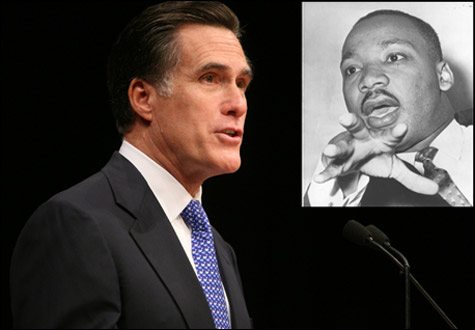
REALLY?: Was Romney just dreaming? |
UPDATED TODAY, DECEMBER 20, 2007, SEE BELOW FOR MORE.
In the most-watched speech of his political career, speaking on “Faith in America” at College Station, Texas, earlier this month, Mitt Romney evoked the strongest of all symbolic claims to civil-rights credentials: “I saw my father march with Martin Luther King.”
He has repeated the claim several times recently, most prominently to Tim Russert on Meet the Press. But, while the late George W. Romney, a four-term governor of Michigan, can lay claim to a strong record on civil rights, the Phoenix can find no evidence that the senior Romney actually marched with King, nor anything in the public record suggesting that he ever claimed to do so.
Nor did Mitt Romney ever previously claim that this took place, until long after his father passed away in 1995 — not even when defending accusations of the Mormon church’s discriminatory past during his 1994 Senate campaign.
Asked about the specifics of George Romney’s march with MLK, Mitt Romney’s campaign told the Phoenix that it took place in Grosse Pointe, Michigan. That jibes with the description proffered by David S. Broder in a Washington Post column written days after Mitt’s College Station speech.
Broder, in that column, references a 1967 book he co-authored on the Republican Party, which included a chapter on George Romney. It includes a one-line statement that the senior Romney “has marched with Martin Luther King through the exclusive Grosse Pointe suburb of Detroit.”
But that account is incorrect. King never marched in Grosse Pointe, according to the Grosse Pointe Historical Society, and had not appeared in the town at all at the time the Broder book was published. “I’m quite certain of that,” says Suzy Berschback, curator of the Grosse Pointe Historical Society. (Border was not immediately available for comment.)
Berschback also believes that George Romney never appeared at a protest, march, or rally in Grosse Pointe. “We’re a small town,” she says. “Governors don’t come here very often, except for fundraisers.”
In fact, King’s only appearance in Grosse Pointe, according to Berschback, took place after Broder’s book was published.
That was for a March 14 speech he delivered at Grosse Pointe High School, just three weeks before King was assassinated. But there was no march, and George Romney was not there.
Security concerns would have made a march impossible, even had one been planned. King was personally driven directly to the high school by the sheriff, as described by accounts at the time.
This 1968 Grosse Pointe appearance is the one that Romney spokesperson Eric Fehrnstrom initially insisted, in email exchanges with the Phoenix, was the event in question. Fehrnstrom cited the Broder column and “the Romney family recollection.”
Of the many contemporaneous and historical records of the Grosse Pointe speech, none make any mention of George Romney’s attendance. It is unlikely, if not implausible, that his presence would have gone unnoticed: not only was he governor of the state, he had just, weeks before, dropped out of the race for President.
And, Mitt Romney would not have known about the event, let alone had a chance to “see” it. He was at that time in the middle of his two-year mission for the Mormon church in Le Havre, France. By his own description and others’, he was cut off from virtually all contact with his family; and at the time, King’s Grosse Pointe appearance was no more than local news.
The original mention, in Broder’s 1967 book, of a Romney-King Grosse Pointe march might have resulted from an accidental conflation of several different events.
In June 1963, King marched in Detroit, and delivered an early version of his “I Have a Dream” speech; Governor George Romney did not participate, according to news accounts of the time.
Later that month, a local organization of roughly 50 members, called the Grosse Pointe Human Rights Council, held a walk through their town in support of open housing.
King had already left the state, and Romney did not participate in the Grosse Pointe walk, according to records from the time.
George Romney would later lead a 10,000-person march through Detroit, but not with King.
Although Broder’s book contained the brief mention, there is nothing in the public record to suggest that George Romney himself ever claimed to have marched with King.
Had George Romney ever marched with Martin Luther King Jr., it almost certainly would have been documented. From the mid-’50s through 1962, Romney was one of the country’s most prominent business leaders — for him to travel South for a civil-rights march would have been remarkable. From January 1963 on, as governor of Michigan and a presumed Presidential candidate, Romney was one of the most visible political figures in the country.
UPDATE: ROMNEY CAMPAIGN SAYS “TOGETHER” MAY MEAN DIFFERENT CITIES, DIFFERENT DAYS
A spokesperson for Mitt Romney now tells the Phoenix that George W. Romney and Martin Luther King Jr. marched together in June, 1963 -- although possibly not on the same day or in the same city.